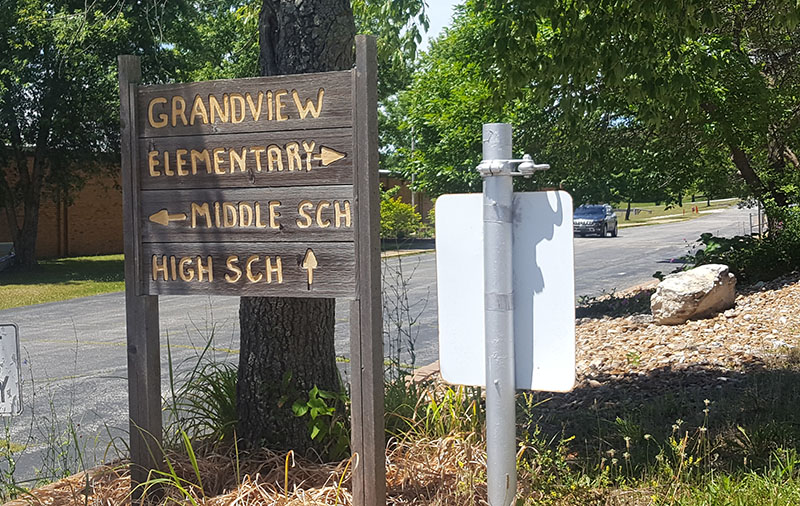BUILDING THE FUTURE: Rural MO School District builds future on virtual education
This is the first of a multiple part series examining how virtual education has transformed a small, rural school district and how that district is expanding its success throughout Missouri.
Drive about an hour south of St. Louis over rolling hills and along windy roads and you will find yourself in the tiny rural school district of Grandview R-2 which served a total of 800 students in 2016.
“There is about a 70 square mile area here where you can’t buy a gallon of gas or a gallon of milk,” says former school Superintendent Dr. Michael Brown, adding that over 40 percent of the school system’s students do not have access to high-speed internet at home.
The district’s three schools, huddled together in a single complex seemingly in the middle of nowhere, may seem like the epitome of rural education.
But don’t the backroads leading to it fool you — Grandview R-2 is actually leading the state in high-tech, virtual education.
Every student has their own digital device. Over 90 percent of the classes, even in elementary school, are hosted on online platforms like Moodle and Blackboard. High school students take classes ranging from Mandarin Chinese to physical education in virtual classrooms.
And, the district serves around 1,300 students from every county in Missouri through their Missouri Online Summer Institute (MOSI).
Brown, who started the district’s move toward virtual education and now serves as the director of MOSI, said they did not set out to become the poster child for virtual education – it just happened naturally as they worked to provide the best options for their students.
“It was really economics that forced us into it,” said Brown. “We had to adapt to meet the needs of our students. We found that kids wanted to take courses we could not offer.”
“We could not compete with the schools that surround us,” agreed current Superintendant Matthew Zoph. “We knew we were not going to have any more money. We knew we could not hire a teacher to teach Chinese.”
So the school system reached out to virtual education provider K12 to start bringing virtual classes in to fill the curriculum gaps.
“Virtual has allowed us to offer anything a public or private institution anywhere in this country in the secondary K-12 market can offer,” said Brown. “And we do it on just $6,200 per student.”
The district uses its own teachers to create and manage many of the courses and supplements with K12 courses for subjects their own teachers are not certified in.
How it works
Grandview’s program has evolved over a decade, starting with providing digital devices to every student and keeping key course materials like lessons, notes, tests and quizzes online.
Today, high school students can use that foundation to take a wide variety of virtual courses to build the education path that fits them best.
“Our high school is set up now where every hour there is basically a study hall for kids to come in and take classes online,” said Zoph. “We have time set aside at the beginning of every day for students to upload work they did at home and the teachers are required to stop classes 10 minutes early to give kids time to download any work they will need for the next day.”
Students taking virtual courses have constant support from the teachers who, in turn, have more tools to monitor student progress.
“There is no reason for a student to fail unless the student wants to fail,” said Brown, noting that teachers can monitor everything from the amount of time students are spending logged into the course to how they are doing with the subject matter in real time. “Our kids have no excuse for falling behind.”
Benefits for students
Zoph said his own son is a perfect example of how the virtual course access is giving students at Grandview a real advantage when looking toward their college careers.
“He took virtual classes during the summer and during the school year and by the middle of his junior year, he had enough credits to graduate,” said Zoph, noting that his son liked the flexibility virtual classes gave him to review material multiple times if need to. “But instead, he started taking AP courses and college credit courses, all virtually. We had 10 kids this year who could have graduated early, but they all stayed because they realized that it would be cheaper for them to get those college credits in high school than it would be in college.”
That ability to bulk up on higher level courses has helped students be more competitive in applying for college.
“We had a young lady this year get the Jack Buck Scholarship,” said Zoph. “We have kids who have gotten Governor’s Scholarships at Missouri State. They would not have been able to take the higher level courses without virtual. Those courses led to the scholarships. They would not be able to compete without the virtual program.”
And, the experience taking classes online is great training for college, where many core courses are now offered online.
“Our kids are coming back to us and telling us it is no problem for them, but that a lot of kids who have not had our experience are struggling with the first online course and the discipline it requires,” said Brown.
Check back next week to learn how Grandview has expanded its virtual offerings to a statewide summer school program.
« Previous Post: CEAM TEAM IN ACTION: Parents complete Advanced Advocacy training
» Next Post: The quickest way to access school data
